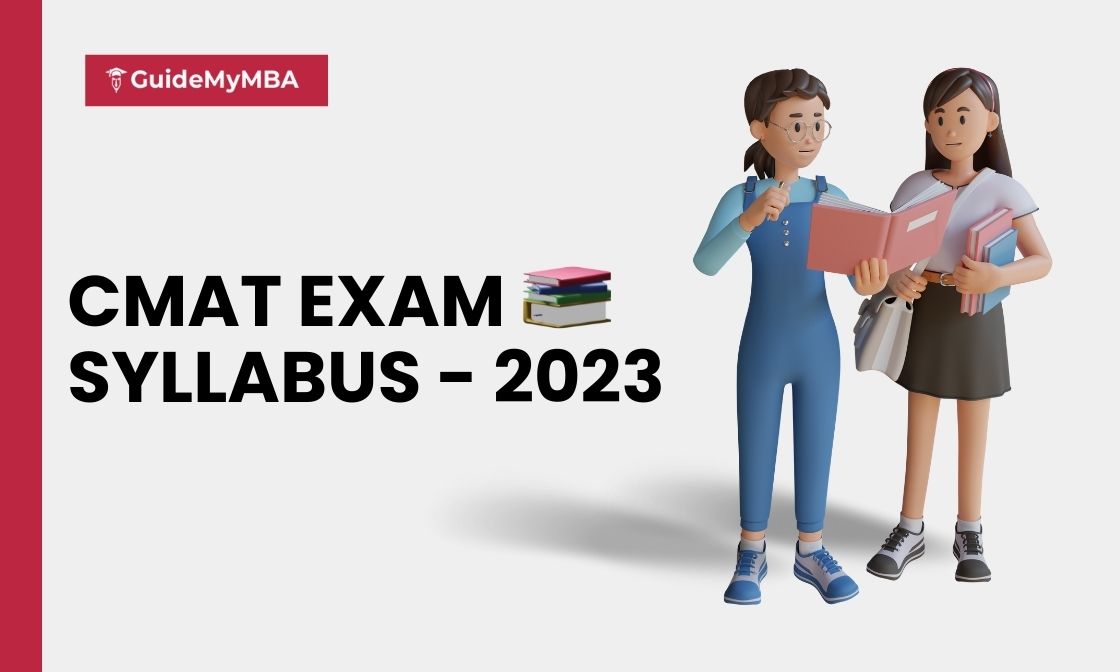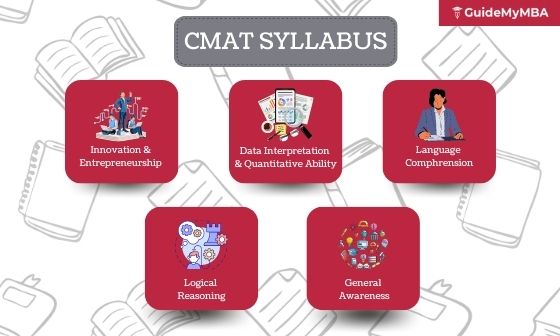CMAT Exam Syllabus 2023
The exam syllabus of CMAT 2023 will includes 5 major sections - Data Interpretation and Quantitative Technique, Language Comprehension, Innovation and Entrepreneurship, Logical Reasoning, and General Awareness. Earlier the Innovation and entrepreneurship section is not mandatory but from 2022 onwards NTA made this section compulsory. CMAT 2023 syllabus has not been declared the AICTE yet but on the basis of CMAT previous year's papers and mock test, our experts prepared this syllabus for you after in-depth analysis. Our details exam syllabus will help the CMAT aspirants in better preparation for all the topics of the upcoming exams.

Modification in CMAT Exam Syllabus 2023
As of now, no major update has been declared by the National Test agency in the CMAT Curriculum. Only the innovation and entrepreneurship section will remain the compulsory like previous year and this section's marks will be counted while calculating the percentile. As soon as any change is introduced by the NTA in the curriculum of CMAT 2023 we will update it here. NTA will release a detailed information bulletin about the circular of the exam along with the CMAT Exam date 2023 notification.
Important Points of Syllabus
| Topic | Details |
|---|---|
| Number of Questions | 100 |
| Number of Sections | 5 |
| Questions Per Questions |
|
| Duration | 180 Minutes |
| Time Per Section | 36 Minutes |
| Exam Language/Medium | English |
| Mode of Examnination | Computer Based Online MCQ Test |
| Total Marks | 400 |
| Marks Per Section | 100 |
| Sectional Cutoff | Not Applicable |
| Marking Scheme | (+4) for every right answer |
| Negative Marking | (-1) for wrong answer |
Overview of CMAT Syllabus

| Classification of Syllabus 2023 | |
|---|---|
| Topic Name | Subtopics |
| Data Interpretation & Quantitative Technique | Percentage, Work & Time, Profit & Loss, Partnership, Fractions, Number, Probability |
| Language Comprehension | Reading Comprehension, Passage, Synonyms & Antonyms, Grammar, Paragraph |
| Innovation & Entrepreneurship | Startup, Innovations, Women Entrepreneurship, Entrepreneurship Trends, Framework of Entrepreneurship |
| Logical Reasoning | Number Series, Venn Diagram, Linear Arrangements, Rankings, Coding & Decoding |
| General Awareness | Business News, Current Affairs, Politics, Awards, Science |
Detailed Syllabus of CMAT 2023
Syllabus of Data Interpretation & Quantitative Technique Section
DI & QT part is prepared to check the basic numerical and analytics ability of the candidates. In total 20 questions will be asked from this section. Among all the sections of the CMAT exam syllabus, this is the high scoring for candidates. It consists of questions from the topics which they have studied in their school time or in graduation.
| Classification of Data Interpretation and Quantitative Technique Syllabus | |
|---|---|
| Topic Name | Subtopics |
| Data Interpretation | Line Chart, Pie Chart, Missing Data Interpretation, Bar Diagram, Tables, Graph, Quadric & Linear Equations |
| Quantitative Ability | Percentage, Work and Time, Ratios & Proportions, Time, Speed & Distance, Pipes & Cisterns, Age, Mensuration, Average, Partnership, Profit & Loss, Arithmetic, Number Properties, Probability, Fractions & Decimals, Steam Boat , Inequalities, Simple and Compound Interest, Allegations & Mixtures, Algebra, Geometry |
Language Comprehension Syllabus
This section evaluates the verbal ability of the candidates in the CMAT exam. It covers topics related to English proficiency such as the use of grammar, paragraphs, reading ability, daggling modifiers, and more. In Rc Passage candidates have to answer the questions based on their understanding of the given passage. It is expected that a passage of a minimum of 500-600 words will be given in the CMAT exam paper.
| Classification of Language Comprehensions | |
|---|---|
| Topic Name | Subtopics |
| Verbal Ability | Articles, Non Finites, Dangling Modifiers , Sentence Corrections, English Usage Correction, Nouns & Pronouns, Jumbled Paragraph, Tenses, Adverbs, Adjectives, Verbs, Syntax, Prepositions, Active & Passive Voice, Subject – Verb Agreement, Vocabulary, Synonyms and Antonyms, one word substitution , Fill in the blanks, Fact Interface and Judgement, Analogues |
| Reading Comprehension | Inference Based Questions, Based on Topic of the Passage, Based of Phrases & Idioms, Based on Expression of Passage |
| Other MBA Entrance Exam | ||
|---|---|---|
| CAT Exam | Exam Date of CAT | CAT Previous Year Paper |
| XAT Exam | Exam Date of XAT 2023 | XAT Registration |
Syllabus of Innovation & Entrepreneurship Section
This section is a recent addition to the exam syllabus of CMAT. Earlier it was not compulsory to solve this section as marks of this section were not considered during the percentile calculation. From 2022 onwards Innovation and Entrepreneurship is a mandatory part and carry 100 marks in the exam.
| Classification of Innovation and Entrepreneurship Syllabus | |
|---|---|
| Topic Name | Subtopics |
| Innovation | Creativity and Stimulation, Strategy, Management Concept of Innovation , Product Portfolio, Innovation in Product Life Cycle, Innovative Project Management , Management System Idea |
| Entrepreneurship | Brief of Entrepreneurship, Models & theories, Trends of Entrepreneurship in India and World, Importance of Entrepreneurship in Economic Development, Leadership, Communication, Motivation, Women In Entrepreneurship, Models & Trends of Corporate Entrepreneurship, Rural Entrepreneurship, Framework of Entrepreneurship, Business Organization Principles & Theories, Startups in India, Evolutions of Entrepreneurship & Startups in India, Business Society – Related to Innovation and Entrepreneurship |
Logical Reasoning Topics for CMAT Exam
It carries a significant weightage not only in the CMAT exam but also in other management entrance exams such as CAT Exam or XAT. The logical reasoning section examines the critical and logical thinking abilities of the candidates. Candidates can score high marks in this portion with a well-optimized strategy.
| Classification of CMAT Logical Reasoning Syllabus | |
|---|---|
| Topic Name | Subtopics |
| Logical Reasoning | Reasoning Analogies, Artificial Language, Blood Relations, Seating & Arrangements, Shape Constructions, Paper Folding, Ages, Order & rankings, Input – Output, Calendars, Cause & Effect, Coding – Decoding, Cube & Cuboids, Figure Matrix, Pattern, Series, Sequences, Puzzles, Odd one out, Directions, Dices, Data Sufficiency, Critical Path & Reasoning, Mirror and Water Image, Clocks , Statement & Assumptions, Statement & Conclusions, Syllogism, Alphanumerical Series |
Syllabus of CMAT 2023 General Awareness
| Classification of General Awareness Syllabus | |
|---|---|
| Topic Name | Subtopics |
| General Awareness | Current Affairs, Economy & Business News, World Records, Women Achievements, Geography, International Relations of India, Trade News, Who’s Who, Awards, Innovation in Science & Technology, Politics, Indian Constitution, Sports, Finance, Laws, Personality in News, Events, History, Books & Their Authors |
Important Points about Exam Syllabus
Before candidates began their preparation here are some points they need to know.
- Above mentioned syllabus is made after a careful analysis of the previous year’s papers. The final Syllabus will be declared by the AICTE.
- CMAT exam does not have a defined structure declared by National Test Agency. It means the syllabus does not have any limitations.
- Syllabus of the exam will cover almost all the major topics from all 5 sections.
- Interestingly the questions never get repeated in CMAT Exam. So if questions appeared in the previous year’s papers then it will not feature in any of the upcoming CMAT exams.
- CMAT exam format, type of questions asked and topics kept on changing every year.
- Most of the time questions related to trending topics are asked in the exam.
Importance of CMAT Syllabus Understanding
It is impossible to streamline exam preparation without having proper knowledge of the exam syllabus. Especially in the case of the CMAT exam where the syllabus does not have any boundaries and anything can be asked in the exam. Knowledge of the syllabus gives information such as important topics, topics that you have mastered, and topics that need more attention. It also helps in strategy preparation candidates can divide their time and effort according to the weightage of a particular subject. With this practice, aspirants can save their time and devote it to other important topics of exams.
